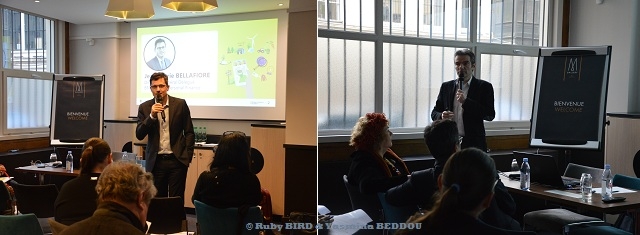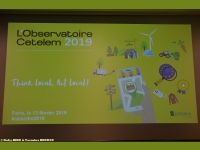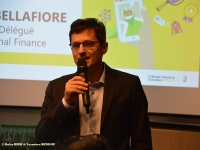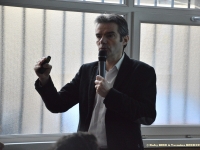Business
THINK LOCAL, ACT LOCAL - L OBSERVATOIRE CETELEM 2019 REPORT
17 European Countries Scrutinized

Jean-Marie BELLAFIORE & Flavien NEUVY (Source: © Ruby BIRD & Yasmina BEDDOU)
USPA NEWS -
On February 13, 2019, was held a Press Conference given by Jean-Marie BELLAFIORE (Deputy General Manager of BNP Paribas Personal Finance) and Flavien NEUVY (CEO of L'Observatoire Cetelem). It was at Hôtel de l'Echiquier in Paris. The Theme was "L'Observatoire Cetelem 2019" Report involving 17 European Countries (Costumers and their Consumption from those Countries) being scrutinized...
On February 13, 2019, was held a Press Conference given by Jean-Marie BELLAFIORE (Deputy General Manager of BNP Paribas Personal Finance) and Flavien NEUVY (CEO of L'Observatoire Cetelem). It was at Hôtel de l'Echiquier in Paris. The Theme was "L'Observatoire Cetelem 2019" Report involving 17 European Countries (Costumers and their Consumption from those Countries) being scrutinized...
The Report was divided in Three Parts :
* Stable Moral Behavior and Increasing Global Saving Intentions
* To consume Local & Responsible Purchasing
* How to Do Better ?
Understanding Household Consumption Patterns is about understanding Human Behaviour. Consumption Patterns in Europe are very Different to those 50 years ago. Important Factors that drive our Consumption include Growing Incomes, Globalisation of the Economy, Technological Breakthroughs (such as the Internet and Mobile Phones), decreasing Household Sizes, an Ageing Population, and Habits and Cultures.
* Stable Moral Behavior and Increasing Global Saving Intentions
* To consume Local & Responsible Purchasing
* How to Do Better ?
Understanding Household Consumption Patterns is about understanding Human Behaviour. Consumption Patterns in Europe are very Different to those 50 years ago. Important Factors that drive our Consumption include Growing Incomes, Globalisation of the Economy, Technological Breakthroughs (such as the Internet and Mobile Phones), decreasing Household Sizes, an Ageing Population, and Habits and Cultures.
We buy increasing Numbers of Electric and Electronic Goods (such as TVs, PCs, Laptops, Mobile Phones and Kitchen Appliances), and we also replace these more frequently than previously... Tourism is Growing Fast, and travel to and from our Destinations is most often by Car or Plane. In Tourist Destinations, Water and Energy Consumption, Land Use, and Waste/Wastewater Generation often have Considerable Environmental Impacts.... Sustainable Consumption is Key in the Plan of Action for Sustainable Development... Consumers learned long ago how to circumvent Price Increases. The Strategies vary according to Economic Situation... To sum up, in all 17 Countries surveyed People are buying but they are buying Differently.
We have Organic Meat, Organic Fruit, Organic Vegetables, Organic Milk, all from Organic Farms that produce them, Organically. We even have Organic Cotton and Hemp Clothing. There are many Rules and Regulations that determine whether something is Organic or not. Having shed its Hippy-Dippy Image, Organic Food is among the Faster-Growing Categories in Supermarkets even though it adds to Food Bills and Studies vary when it comes to perceived Health Benefits. The Demand for Organic extends from Supermarket Aisles to the Multitude of Farmers Markets that have sprung up... Interest is booming, it is due to a More Conscientious Consumer and Improved Farming Practices that make Organic Yields more Robust.
Product Quality is also how well the Product does what it's supposed to do, and how well it holds up over Time. Some Consumers view Quality as a Price Point while others appreciate a Product because it´s “Greener.“ Regardless of the Various Viewpoints from the Public, Product Quality is a Competitive Marker for Brands that affects Purchasing Decisions and Profitability. 92% of People trust Recommendations from Friends and Family above all other Forms of Advertising when making a Purchase Decision. This is why when it comes to Influencing Consumers, nothing comes close to Beating Word of Mouth. One Dimension of Quality is how a Product Looks, Feels, Sounds, Tastes or Smells. The Colors, Prints, Shapes, Textures and Features make all the Difference, and it´s what sets them Apart from the Competition. Customers notice this Kind of Details, and they can make or break a Sale...
-- "L'Observatoire Cetelem 2019" Report :
* The Countries involved in the Study/Survey were : France, Germany, Austria, Belgium, Bulgaria, Danemark, Spain, Hongria, Italia, Norway, Poland, Portugal, Czech Republic, Romania, UK, Slovakia, Sweden. 800 people were interviewed by Country (Total = 13,800 People from 18 to 75 Years old)
* Three Issues were coming up : Globalization, Digitalization (e-Commerce), Purchasing Power (Personal Income)... All involving Budget Management, Budget Constraint, Local Purchase, Fostering Social Ties in the Region/Country, Responsible Purchasing...
* The Countries involved in the Study/Survey were : France, Germany, Austria, Belgium, Bulgaria, Danemark, Spain, Hongria, Italia, Norway, Poland, Portugal, Czech Republic, Romania, UK, Slovakia, Sweden. 800 people were interviewed by Country (Total = 13,800 People from 18 to 75 Years old)
* Three Issues were coming up : Globalization, Digitalization (e-Commerce), Purchasing Power (Personal Income)... All involving Budget Management, Budget Constraint, Local Purchase, Fostering Social Ties in the Region/Country, Responsible Purchasing...
* There is No Brutal Stop of the Global Economic Growth, keep being Stable even if the Projections for 2019 are falling a bit. The Reasons might be due to Brexit, China, USA...
* The Moral is still Positive in Europe, except Three Countries : Belgium, France and Sweden
* Sense of Personal Situation improving, except Three Countries : Belgium, Bulgaria and France
* General Sense of Falling Purchasing Power (Pessimistic), mostly Belgium, Danemark, Spain, France, Portugal, Czech Republic, Romania, and Sweden
* The Changes in Expenditure Patterns : the Spending Constraints are on Significantly Increaseing (Accommodation, TV, Communication, Electricity / Gaz Billsn Health...)
* Less Savings in Belgium, France, Italy. The Average European Savings Level for 2018-2019 is of 49%
* Global European Buying Intentions are down (Average European : 41%, Progress 2018-2019 : -6%)
* The Moral is still Positive in Europe, except Three Countries : Belgium, France and Sweden
* Sense of Personal Situation improving, except Three Countries : Belgium, Bulgaria and France
* General Sense of Falling Purchasing Power (Pessimistic), mostly Belgium, Danemark, Spain, France, Portugal, Czech Republic, Romania, and Sweden
* The Changes in Expenditure Patterns : the Spending Constraints are on Significantly Increaseing (Accommodation, TV, Communication, Electricity / Gaz Billsn Health...)
* Less Savings in Belgium, France, Italy. The Average European Savings Level for 2018-2019 is of 49%
* Global European Buying Intentions are down (Average European : 41%, Progress 2018-2019 : -6%)
* Top Three Products/Services First Concerns for 2019 : Travel & Pleasure (60%), Household Appliances (43%), Smartphones (37%)
* Globally, Consumers are much concerned buying Local / Regional / Country than European which has a lot less impact in their Decisions Making.
* European Consumers are divides in Four Types of Motivation when Purchasing : an act in favor of the environment (mostly Central Europe and Northern Countries), a Goal you set for Yourself (Spain), A Patriotic Act (Eastern European Countries), A Duty (Portugal)
* Majority of Euroean Consumers justify their Purchase by : This will support the Economy (49%), This will support Employment (43%), They are Products of Better Quality (35%), They are Reassuring Products (32%), Supporting Local Purchasing is important Socially (30%), This will limit the Environmental Impact (25%)...
* Globally, Consumers are much concerned buying Local / Regional / Country than European which has a lot less impact in their Decisions Making.
* European Consumers are divides in Four Types of Motivation when Purchasing : an act in favor of the environment (mostly Central Europe and Northern Countries), a Goal you set for Yourself (Spain), A Patriotic Act (Eastern European Countries), A Duty (Portugal)
* Majority of Euroean Consumers justify their Purchase by : This will support the Economy (49%), This will support Employment (43%), They are Products of Better Quality (35%), They are Reassuring Products (32%), Supporting Local Purchasing is important Socially (30%), This will limit the Environmental Impact (25%)...
* Extreme Majority of People are Confident in the Products coming from their Country (94%), Their Region (93%), Another European Country (75%), USA (61%), South Korea (39%), China (26%)
* The Offer of Products is Too Small, not Enough Known : Grocery (EU = 93%, France = 91%), Home Furnishing (EU = 59%, France = 36%), Hu-ygiene & Beauty (EU = 55%, France = 41%), Textile (EU = 54%, France = 30%), Technology & High-Tech (EU = 35%, France = 21%)
* People are in Majority Willing to Prefer the Goods produced in their Own Country
* People Main Concerns are mostly regarding Price, Quality, Style (Clothing), Taste (Food), Sustainability (Technology & High-Tech)... All depends really on the Different Sector (Food, Homs Furnishing, Clothing, Technology).
* The Price is finally the Final Constraint when Purchasing Local. Eu (61% Yes, 39% No - France 56% Yes, 44% No)
* Strong Expectations when Purchasing Locally : 39% High Priority, 56% Important but not High Priority, 5% Not Important.
* The Offer of Products is Too Small, not Enough Known : Grocery (EU = 93%, France = 91%), Home Furnishing (EU = 59%, France = 36%), Hu-ygiene & Beauty (EU = 55%, France = 41%), Textile (EU = 54%, France = 30%), Technology & High-Tech (EU = 35%, France = 21%)
* People are in Majority Willing to Prefer the Goods produced in their Own Country
* People Main Concerns are mostly regarding Price, Quality, Style (Clothing), Taste (Food), Sustainability (Technology & High-Tech)... All depends really on the Different Sector (Food, Homs Furnishing, Clothing, Technology).
* The Price is finally the Final Constraint when Purchasing Local. Eu (61% Yes, 39% No - France 56% Yes, 44% No)
* Strong Expectations when Purchasing Locally : 39% High Priority, 56% Important but not High Priority, 5% Not Important.
Finally, People consider the following Economic Actors to the Most concerned in Helping Purchasing Local : Craftsmen / Shopkeepers (80%), Associations (76%), Citizen / Consumers (67%), Brands / Distributors Brands (59%), Companies (56%), Media (49%), Governement / Public Institutions (44%), EU (42%)
Source : Press Conference on February 13, 2019 at L'Hôtel De L'Echiquier in Paris with the Presence of Jean-Marie Bellafiore (Deputy General Manager BNP Paribas Personal Finance) & Flavien Neuvy (Director of L'Observatoire Cetelem)
Ruby BIRD
http://www.portfolio.uspa24.com/
Yasmina BEDDOU
http://www.yasmina-beddou.uspa24.com/
Source : Press Conference on February 13, 2019 at L'Hôtel De L'Echiquier in Paris with the Presence of Jean-Marie Bellafiore (Deputy General Manager BNP Paribas Personal Finance) & Flavien Neuvy (Director of L'Observatoire Cetelem)
Ruby BIRD
http://www.portfolio.uspa24.com/
Yasmina BEDDOU
http://www.yasmina-beddou.uspa24.com/
Ruby Bird Yasmina Beddou Think Local Act Local L Observatoire Cetelem 2019 Report 17 European Countries Scrutinized Bnp Paribas
Liability for this article lies with the author, who also holds the copyright. Editorial content from USPA may be quoted on other websites as long as the quote comprises no more than 5% of the entire text, is marked as such and the source is named (via hyperlink).








